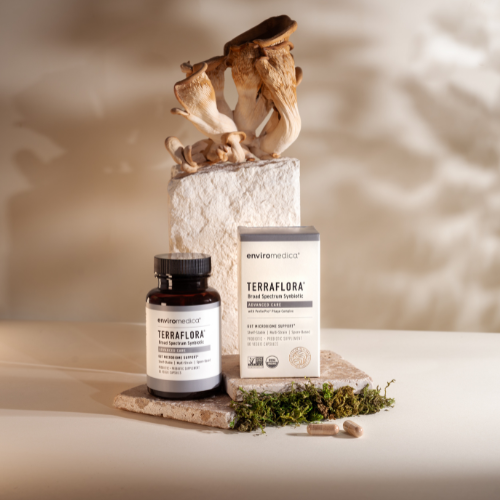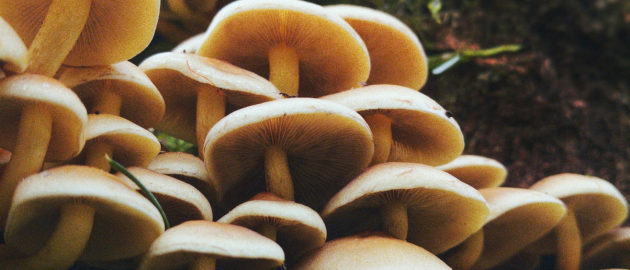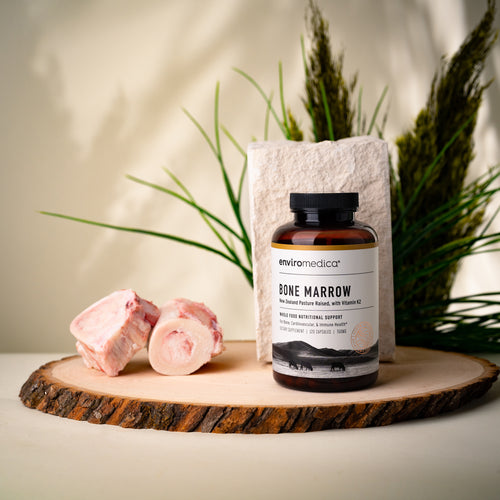Modern Delicacy, Ancestral Dietary Complement
Bone marrow is a modern culinary delicacy, an ancestral dietary complement, and literally the life-blood of mammalian bodies. Bone marrow itself is the focus of a broad spectrum of study, including: stem cell therapeutic,1 oncologic,2 endocrine,3 piezoelectric,4 gravitational,5 immunologic,6 7 micro-environmental,8 9 microbial,10 and anthropologic.11 Supplementation of bone marrow and its constituent compounds are the focus of cancer therapy, wound healing, immunologic, therapeutic, and anti-inflammatory study.12
This primeval substance, so integral in shaping the cellular direction of life in vivo, may also be integral in shaping the immunologic direction of life when consumed.
Bone marrow has several primary functions in the human body that are influenced by its environment. The theoretical boundaries of the ‘bone marrow’ environment (and any internal organ, for that matter) extend far beyond the human / mammalian body and indicate holistic interaction with nature is a requirement for its optimal function.
What exactly is bone marrow? Why is it important from a human evolutionary perspective? What environments influence its function? And why would anyone want to consume it?
What Is Bone Marrow?
For centuries, poets, healers, and philosophers saw and described the close link between blood and life. Not so the marrow. Its role as the seed bed of blood lay hidden, like a seed in the soil” – Tavassol13
While the details of the cellular function and microenvironment of bone marrow are still under investigation to this day, hypotheses around its role in the body stem from the time of Hippocrates. Through “observation and reasoning rather than mysticism”,14 Hippocrates (460-375 BC) described marrow as a source of nutrition for the bone. Aristotle described bone marrow to be the excrementum ossium, an environment created by the waste products of bone. Later observation that not all bones contain marrow (1700’s, French anatomist Duverney) and that marrow was formed after the bone (Charles Robin, 1872) led scientists to conclude that marrow is not present to simply ‘nourish the bone’.15
Although the significance of bone formation over marrow formation is still in question,16 17 there is scientific agreement around general bone marrow characteristics and function. Bone marrow forms the core of flat bones and vertebrae in the human body. There are broadly two types of bone marrow: red and yellow.
- Red bone marrow, also known as myeloid tissue, is where 100s of billions of blood cells are formed daily in a process called hematopoiesis. Newborn mammals have primarily red bone marrow, actively creating new blood cells.18 Red bone marrow appears to be intimately connected to the development and replacement of cartilaginous fetal skeletal structure.19 Red bone marrow contains collagen and tends to be concentrated in bones near the head, neck, and trunk.
- Yellow bone marrow, or fatty bone marrow, is non-hematopoietic. It is primarily made of mesenchymal stromal cells. Yellow marrow may be an important endocrine organ, producing adiponectin during caloric restriction, consequently effecting metabolism.20 Yellow bone marrow also contains collagen and tends to be concentrated in the extremities.21
As you might suspect, red and yellow bone marrow work in concert. As a human grows, their red bone marrow is gradually replaced by yellow bone marrow. But when the bodily demand for increased blood production arises, yellow bone marrow can regenerate or switch into red bone marrow. This dynamic, regenerative capability of bone marrow is made possible by local mesenchymal stem cells (MSCs) bound to endosteal (the longer tubular part of the bone) and trabecular (the porous ends of the long bone) surfaces of bone. Gurevitch et al (2007) speculate that more red marrow exists in trabecular-type bone where there is more micro-environmental surface area for MSCs to thrive.22 23
Bone Marrow and Stem Cells
The bone marrow micro-environment contains stem cells. Stem cells are primordial cells in the body capable of self-renewal and of generating other cell types. As we experience the healing of wounds, healing from viruses, healing of gut tissues, even the spontaneous healing from cancer, it is reasonable to intuit that our bodies are designed to heal under natural conditions and that stem cells play a role in this process.
Embryonic Stems Cells (ESCs) are pluripotent as they form all cells of the adult body. As ESC research is limited for ethical reasons, Adult Stem Cells (ASCs) have moved into the spotlight. The natural function of ASCs is renewal of tissues local to the environment and therefore they are thought to have limited differentiation capability (multipotency or unipotency). Although ASCs are known to exist in the brain (neural), gut (epithelial), skin (epidermal), eye (corneal), connective tissues (mesenchymal), and bone marrow (hematopoietic and mesenchymal), researchers speculate that all tissues in the human body have stem cell compartments.24 25
Mesenchymal Stem Cells (MSCs) are multipotent ASCs found in bone marrow that differentiate into bone cells, cartilage cells, fat cells, brain cells, and liver cells. They have immunomodulatory and anti-inflammatory properties that attract researchers interested in mitigating chronic disease through stem cell therapies.26
For research and therapeutic purposes, bone marrow is the most common source of ASCs. Stem cell therapy (bone marrow transplantation) has been used for decades to treat blood diseases. Future efforts in stem cell therapy lie in understanding how to stimulate stem cells already in residence to treat disease, restore function, and reduce inflammation without pharmaceutical interventions.27 28 29 From an ancestral perspective, ‘stem cell therapy’ involves immersing the body in the ecologically appropriate environment for optimal health.
Immune Cells
Bone marrow contains T-cells, regulatory T-cells, B-cells, dendritic cells, natural killer T cells, neutrophils, suppressor cells, as well as MSCs making it important to study from an immunological perspective. It has been proposed to be an immune-regulatory organ.30 31 The immune function of bone marrow is influenced both by its micro-environment and macro-environment.
Bone Marrow and Human Evolution
From the ancestral and ecosystem perspective, it is important to consider a holistic review of bone marrow: from the elementary principles of health related to its function to its presence in the food chain, both of equal relevance as health is traditionally derived and maintained from natural interaction with the ecosystem.
When viewed through this lens, it is easy to observe how bone marrow, both in your body and in other mammals, is in communication with its environment. Consider the elementary principles of ancestral health: food from nature, sun, movement, connection to the Earth, and community. Now consider how we relate to these principles today. This defines an evolutionary disconnect from which hypotheses on the roots of modern disease spring forth.
Food
Food is fundamentally nutrient information to the body, and from an ancestral perspective, its procurement involved receiving information from all principles of evolutionary health.
To hunt and forage meant:
• hours of daily movement
• being outside exposed to the sun
• being in community and working for a common purpose
• touching the Earth and being immersed in one’s ecosystem
• sometimes eating, sometimes not
• and ultimately, local, seasonal, nose-to-tail eating
Compare this to the information that ‘gathering’ a meal brings to your body today, where a typical meal contains industrially-processed food and ingredients delivered to you from the far reaches of the world, is likely eaten alone, indoors, and requires very little movement to assemble. This is the characteristic environment in which we build our bodies today. From here, we speculate that bone marrow – and the health of the whole body – is not optimally supported in the modern western world.
Note that from this perspective, if food is sourced naturally and consumed in the appropriate context it makes sense that it supports health, simply because it nourished the people who made our lives possible.
Bone marrow consumption is hypothesized to have contributed to the increase in brain size characteristic of human evolution history. Cordain et al (2001) argue that brain growth required a very energy dense diet and given the life-way of our ancestors, bone marrow and brain itself were the most energy dense options available. Early hominids were small in stature and likely to be confrontational scavengers who worked together to secure prey from a larger predator.32 In this scenario, the most energy dense (fatty) remaining part of an animal would likely remain protected in bone: the brain or the bone marrow.33
It is also true that our ancestors experienced times of feast and times of famine. Food abundance was directly influenced by geographic location, seasons, and ability to harvest animals from the landscape. It might not surprise you to learn researchers are discovering that fasting stimulates bone marrow and stem cell activity that is critical to immune health.34
From a traditional cuisine and modern functional medicine perspective, bone broth is very medicinal. Simmering beef marrow bones (or chicken or fish bones) with veggies and vinegar for several days releases gelatin, chondroitin sulfate, various minerals, and yet unknown compounds into a healing, nourishing broth. The South African proverb that ‘good broth will resurrect the dead’35 has recently been put to the test. Specifically, homemade chicken broth is shown to have anti-inflammatory properties36
While it’s interesting and even important from an educational perspective that science validates tradition, it’s far from necessary for anyone who has experienced the health benefit from homemade bone broth made from marrow bones.
Sun
All organisms on Earth are in relationship with the Sun. Without the Sun, there would be no photosynthesis, no plants. One could argue that animals are solar creatures too. The Sun drives circadian rhythms that directly influence our hormonal choreography,37 the biology of our microbiota,38 and consequently our ability to grow and heal (immune health).
Vitamin D deficiency is correlated with impaired immunity, muscle weakness, low bone density, glucose intolerance, cancer, cardiovascular disease, and a host of other health concerns. Patients undergoing hematopoietic stem cell transplant (bone marrow transplant) are at increased risk of adverse events when their vitamin D levels are low.39 Functionally, there are three ways to increase vitamin D levels: eating vitamin D-rich whole foods, isolated supplementation, or experiencing sunlight. While vitamin D-rich foods are important to consume for the required cofactors they contain (unlike isolated supplementation), brief exposure to mid-day sun without sunscreen delivers ~10 times the amount of vitamin D to the body than is available from food. Sunscreen with SPF 15 results in a 99% decrease in vitamin D production via the skin.40
Sunlight is a catalyst for bone marrow and stem cell processes via vitamin D metabolism and sufficiency. The Sun acts on cholesterol in the skin to create vitamin D3 (cholecalciferol), which is processed through the liver and kidneys to be transformed into the active form of vitamin D (calcitriol). Researchers are finding site-specific vitamin D conversion in various tissues throughout the body. Human bone marrow stromal cells are capable of metabolizing vitamin D that subsequently initiate differentiation of osteoblasts, chondrocytes, adipocytes from MSCs in vitro.41 42
Our ancestors had a relationship with the Sun, sans sunscreen, that drove physiological processes. They were also moving, and touching the Earth, connecting with microbes, and connecting with their community while in the Sun. Our modern society and habits keep us from this holistic experience and the health that it supports.
Movement and Load
Movement in conjunction with gravitational load is known to be important for bone growth and strength. It is conventional wisdom that we should experience weight-bearing exercises to maintain bone density and integrity. How does bone marrow factor into this equation? On a cellular level, the conversion of mechanical stimulus to a biochemical or electrochemical process in the body is known as mechanotransduction.43 Bone marrow cells are mechanosensitive and are found to induce bone formation under mechanical stress independent of osteocyte signaling. Increased ossification is not simply correlated to increased load on the bone, but deformation of the bone marrow itself.44
Bone marrow is in intimate relationship with blood cell generation, stem cell differentiation, immune cells, sunlight (via vitamin D), bone microenvironment, osteogenesis, and mechanical stressors that set up a framework for health and resiliency on this planet. Layer on top of this the gravitational pull that shapes the form and function of all life on Earth.45 The Canadian Space Agency (CSA) understands this larger perspective and has funded the MARROW study to investigate change in bone marrow under zero gravity conditions. Researchers at the University of Ottawa hypothesize that bone marrow functions differently in space and aim to learn more about reported abnormalities in red and white blood cells, including spaceflight anemia, susceptibility to infections, and thrombosis.
Movement across the landscape in community was a large part of ancestral life. One had to move to eat, consequently experiencing varied terrain and texture (flat surfaces are atypical in nature), gaining strength, balance, and health as a result. Movement initiates capillarization, expanding the reaches of the cardiovascular system to bring nutrients to our cells and whisk cellular waste away.46 It decreases the cardiovascular burden on the heart through vasodilation and vasoconstriction and simultaneously stimulates bone marrow activity as new red blood cells are generated.47 Movement is an important and primal stimulus for optimal health and physiological function of bone marrow and all of our integrated self.
Connection with Nature
Three aspects to this principle element of ancestral health are presented here, all invisible to our primary senses: geophysical fields, microbial fields, and what might be called ‘forest’ interactions. All have potential to influence bone marrow microenvironment and function.
Earth’s ecosystems are shaped by their evolution within geophysical fields: gravitational and electromagnetic. This planet has a very subtle continuous direct current that influences all organisms in contact with it. It is different from the electrical current in your home that is a manmade, higher frequency alternating current. Manmade Electromagnetic Frequencies (EMFs) are polarized unlike natural EMFs, potentially triggering negative biological effects.48
There are several studies suggesting our lack of contact with the Earth negatively influences our health. Where once upon a time we were in daily 100% contact with the Earth, today we spend large parts of our lives completely insulated from it by wearing shoes and living on non-conductive surfaces. Contractors know the importance of grounding home electrical panels and plumbing systems to safely discharge stray voltage into the Earth. What if we are meant to be grounded too? Regular grounding or ‘earthing’ decreases joint pain, improves sleep quality, speeds up muscle recovery from exercise, aids in wound healing, syncs circadian cortisol and melatonin cycles, improves immunity, and decreases inflammation.49
If we are missing a vital ‘earth’ nutrient, the benefits of contact with the Earth extend to bone marrow via our own bioelectrical systems. The movement of a cell in a weak direct current is called ‘electrotaxis’, and when we’re alive, human beings are conductive, electrical beings. Contact with and reinforcement from Earth’s natural direct current may help our bodies to guide cell migration and stem cell differentiation.50 The movement of cells in response to electrical fields may be the reason bone marrow derived MSCs are recruited to the site of a wound to begin the healing process. When Bone Marrow Adherent Cells (BMACs) are in an external electric field, they are accelerated and differentiated; MSCs move toward the cathode, and macrophages toward the anode.51 52
Immersion in nature blankets us with a microbial ecosystem that is vastly different from microbes cultivated indoors. Contact with rich and diverse microbial species of natural environments is beneficial to immune, physical, and mental health. This is especially true of natural environments that have not been modified with herbicides, pesticides, or genetically modified organisms.
To add to a growing understanding of why commensal microbes are imperative to our health, recent recognition of a ‘gut-liver-bone’ axis shows that microbiota in our bodies influence immunomodulation in bone marrow via immunostimulatory effects in the liver.53
Finally, it is hypothesized that phytoncides in forest air influence our immune systems and stress response. Phytoncides are aromatic essential oils emitted by trees as an insecticide or bacteriocide. This is part of a study surrounding a Japanese health practice called forest bathing, or Shinrin-yoku, where people visit forests to heal. Studies indicate that NK cell numbers and activity, various other immune markers in the blood, and adrenaline concentrations respond favorably when ‘bathed’ in the forest as compared to the city, and NK cell activity remained increased up to 30 days post-forest visit.54 55 While there is no direct documentation of the effect of forest bathing on bone marrow per se, we can intuit that bone marrow activity would be increased based on the increased immune response.
No matter how you look at it, all our parts interact systemically to create health, and all our inputs play a role in the system-wide health of our bodies. Bone marrow is a dynamic immuno-vascular-endocrine ‘organ’ that is quite responsive to internal and external stimulus, so much so that despite being housed within certain bones in the body, its boundaries appear to transcend those limits. This transcendence is in part evidenced by the medicinal properties that it takes on if consumed.
Bone Marrow as Medicine
Beside the fact that bone marrow is A) on the menu at many restaurants and is enjoyed world-wide as a delicacy and B) has been part of the human diet for 10-100s of thousands of years, bone marrow and its constituent elements have been the focus of research as a cancer therapy. Factors in bone marrow have been found to boost the immune system, stimulate the production of white blood cells, protect tissues from radiation injury, and increase cancer survival rates when supplemented.
The primary compound of interest is called Alkylglycerol (AKG). The discovery of AKG is rooted in the traditional remedies of Shark Liver Oil (SLO) for wound healing, gastrointestinal issues, and respiratory distress. Scientists were interested in the healing properties of SLO and aimed to isolate compounds to create medicine. AKG was first discovered in SLO in the 1920s and successfully isolated from it in 1930. In nature however, AKG is always esterified with fatty acids, potentially important cofactors in the healing process. AKG is also found in bone marrow, spleen, liver and human milk.56 (see Table 1 for % AKG by weight, data from57 58
Table 1. % AKG Composition (by weight)
| AKG | Human Bone Marrow | Human Milk | Liver Oil: Greenland Shark |
| 14:0 | – | – | 2.0 |
| 15 | – | – | 0.7 |
| 16:0 | 29.4 | 23.9 | 9.4 |
| 16:1 | – | trace | 10.8 |
| 17 | 7.6 | 3.6 | 3.6 |
| 18:0 | 24.6 | 22.8 | 2.8 |
| 18:1 | 16.7 | 33.8 | 59.4 |
| 18:2 | – | 1.4 | 1.6 |
| 18:3 | – | – | unknown |
| 19 | 6.1 | 2.4 | 1.5 |
| 20:0 | 2.9 | 1.6 | – |
| 20:1 | 3.2 | 2.3 | 6.2 |
| 22:0 | 0.7 | 0.7 | – |
| 22:1 | 5.1 | 3.4 | 2.2 |
| 24 | – | 2.1 | – |
In the 1950s, Dr. Brohult used AKG from calf marrow to treat childhood leukemia. She successfully stimulated the production of white blood cells with her approach. Dr. Brohult and her colleagues went on use AKG in the treatment of thrombocytopenia, a condition characterized by too few platelets. They also administered AKG orally and prophylactically to successfully increase the rates of survival for patients with uterine and cervical cancers and to protect them from radiation-induced injury.59 60 61 62
AKG has been shown to boost the immune system by stimulating hematopoietic processes and prompting cytotoxic macrophages into action. AKG may play a role in opening the blood brain barrier (BBB) to assist in the delivery of therapeutic central nervous system drugs, and has been associated with antibacterial and antifungal activity in the body.63 Given the current hypothesis that Alzheimer’s Disease may be correlated with bacteria in the brain,64 we can speculate that the ability of AKG to penetrate the BBB and as an anti-bacterial may make bone marrow supplementation a real food-is-medicine solution.
Consuming Bone Marrow
From the ancestral perspective outlined above, it’s easy to understand what makes a healthy mammal. Healthy mammals have healthy bodies shaped by their environments. This not only matters from a human health point of view, but from a larger ecological point of view. If one were to decide to consume marrow today, as their ancestors did, it makes sense to source it from the healthiest mammals. These source mammals should be born into and raised in the most mammal-appropriate environment with access to pristine natural foods, free to roam about, and even protected by strict animal welfare laws, a place like New Zealand for example.65–66
Principles of evolutionary health apply to all living creatures on Earth.
If you choose the bone marrow appetizer on the menu or the marrow bones to make your own bone broth, be sure to learn where and under what conditions they were sourced. If you are among the people unlikely to eat bone marrow just because your ancestors did, but are interested in the potential immunological health benefits, you can supplement with whole food bone marrow in a way that might be more familiar to you.
References
- 1. Watt, F. M. & Driskell, R. R. 2010. The therapeutic potential of stem cells. Philos Trans R Soc Lond B Biol Sci, 365, 155-63.
- 2. Brohult, A., Brohult, J., Brohult, S. & Joelsson, I. 1977. Effect of alkoxyglycerols on the frequency of injuries following radiation therapy for carcinoma of the uterine cervix. Acta Obstet Gynecol Scand, 56, 441-8
- 3. Cawthorn, W. P., Scheller, E. L., Learman, B. S., Parlee, S. D., Simon, B. R., Mori, H., Ning, X., Bree, A. J., Schell, B., Broome, D. T., Soliman, S. S., Delproposto, J. L., Lumeng, C. N., Mitra, A., Pandit, S. V., Gallagher, K. A., Miller, J. D., Krishnan, V., Hui, S. K., Bredella, M. A., Fazeli, P. K., Klibanski, A., Horowitz, M. C., Rosen, C. J. & Macdougald, O. A. 2014. Bone marrow adipose tissue is an endocrine organ that contributes to increased circulating adiponectin during caloric restriction. Cell Metab, 20, 368-375.
- 4. More, N. & Kapusetti, G. 2017. Piezoelectric material – A promising approach for bone and cartilage regeneration. Med Hypotheses, 108, 10-16.
- 5. Ozcivici, E. 2013. Effects of spaceflight on cells of bone marrow origin. Turk J Haematol, 30, 1-7.
- 6. Mercier, F. E., Ragu, C. & Scadden, D. T. 2011. The bone marrow at the crossroads of blood and immunity. Nat Rev Immunol, 12, 49-60.
- 7. Iannitti, T. & Palmieri, B. 2010. An update on the therapeutic role of alkylglycerols. Mar Drugs, 8, 2267-300.
- 8. Gurevitch, O., Slavin, S. & Feldman, A. G. 2007. Conversion of red bone marrow into yellow – Cause and mechanisms. Med Hypotheses, 69, 531-6.
- 9. Guezguez, B., Campbell, C. J., Boyd, A. L., Karanu, F., Casado, F. L., Di Cresce, C., Collins, T. J., Shapovalova, Z., Xenocostas, A. & Bhatia, M. 2013. Regional localization within the bone marrow influences the functional capacity of human HSCs. Cell Stem Cell, 13, 175-89
- 10. Novince, C. M., Whittow, C. R., Aartun, J. D., Hathaway, J. D., Poulides, N., Chavez, M. B., Steinkamp, H. M., Kirkwood, K. A., Huang, E., Westwater, C. & Kirkwood, K. L. 2017. Commensal Gut Microbiota Immunomodulatory Actions in Bone Marrow and Liver have Catabolic Effects on Skeletal Homeostasis in Health. Sci Rep, 7, 5747.
- 11. Cordain, L., Watkins, B. A. & Mann, N. J. 2001. Fatty acid composition and energy density of foods available to African hominids. Evolutionary implications for human brain development. World Rev Nutr Diet, 90, 144-61.
- 12. Iannitti, T. & Palmieri, B. 2010. An update on the therapeutic role of alkylglycerols. Mar Drugs, 8, 2267-300.
- 13. Davidson, C. S. 1982. Blood, Pure and Eloquent: A Story of Discovery, of People and of Ideas. Edited by Maxwell M. Wintrobe. New York: McGraw-Hill, 1980. (Price not given.). Hepatology, 2, 518S-518S.
- 14. Cooper, B. 2011. The origins of bone marrow as the seedbed of our blood: from antiquity to the time of Osler. Proc (Bayl Univ Med Cent), 24, 115-8.
- 15. Cooper, B. 2011. The origins of bone marrow as the seedbed of our blood: from antiquity to the time of Osler. Proc (Bayl Univ Med Cent), 24, 115-8.
- 16. Zhou, H., Choong, P. F., Henderson, S., Chou, S. T., Aspenberg, P., Martin, T. J. & Ng, K. W. 1995. Marrow development and its relationship to bone formation in vivo: a histological study using an implantable titanium device in rabbits. Bone, 17, 407-15.
- 17. Charbord, P., Tavian, M., Humeau, L. & Peault, B. 1996. Early ontogeny of the human marrow from long bones: an immunohistochemical study of hematopoiesis and its microenvironment. Blood, 87, 4109-19.
- 18. Gurevitch, O., Slavin, S. & Feldman, A. G. 2007. Conversion of red bone marrow into yellow – Cause and mechanisms. Med Hypotheses, 69, 531-6.
- 19. Charbord, P., Tavian, M., Humeau, L. & Peault, B. 1996. Early ontogeny of the human marrow from long bones: an immunohistochemical study of hematopoiesis and its microenvironment. Blood, 87, 4109-19.
- 20. Cawthorn, W. P., Scheller, E. L., Learman, B. S., Parlee, S. D., Simon, B. R., Mori, H., Ning, X., Bree, A. J., Schell, B., Broome, D. T., Soliman, S. S., Delproposto, J. L., Lumeng, C. N., Mitra, A., Pandit, S. V., Gallagher, K. A., Miller, J. D., Krishnan, V., Hui, S. K., Bredella, M. A., Fazeli, P. K., Klibanski, A., Horowitz, M. C., Rosen, C. J. & Macdougald, O. A. 2014. Bone marrow adipose tissue is an endocrine organ that contributes to increased circulating adiponectin during caloric restriction. Cell Metab, 20, 368-375.
- 21. Gurevitch, O., Slavin, S. & Feldman, A. G. 2007. Conversion of red bone marrow into yellow – Cause and mechanisms. Med Hypotheses, 69, 531-6.
- 22. Gurevitch, O., Slavin, S. & Feldman, A. G. 2007. Conversion of red bone marrow into yellow – Cause and mechanisms. Med Hypotheses, 69, 531-6.
- 23. Guezguez, B., Campbell, C. J., Boyd, A. L., Karanu, F., Casado, F. L., Di Cresce, C., Collins, T. J., Shapovalova, Z., Xenocostas, A. & Bhatia, M. 2013. Regional localization within the bone marrow influences the functional capacity of human HSCs. Cell Stem Cell, 13, 175-89.
- 24. Watt, F. M. & Driskell, R. R. 2010. The therapeutic potential of stem cells. Philos Trans R Soc Lond B Biol Sci, 365, 155-63.
- 25. Chagastelles, P. C. & Nardi, N. B. 2011. Biology of stem cells: an overview. Kidney Int Suppl (2011), 1, 63-67.
- 26. Ullah, I., Subbarao, R. B. & Rho, G. J. 2015. Human mesenchymal stem cells – current trends and future prospective. Biosci Rep, 35.
- 27. Watt, F. M. & Driskell, R. R. 2010. The therapeutic potential of stem cells. Philos Trans R Soc Lond B Biol Sci, 365, 155-63.
- 28. Cheng, C. W., Adams, G. B., Perin, L., Wei, M., Zhou, X., Lam, B. S., Da Sacco, S., Mirisola, M., Quinn, D. I., Dorff, T. B., Kopchick, J. J. & Longo, V. D. 2014. Prolonged fasting reduces IGF-1/PKA to promote hematopoietic-stem-cell-based regeneration and reverse immunosuppression. Cell Stem Cell, 14, 810-23.
- 29. Kim, M. S., Lee, M. H., Kwon, B.-J., Kim, D., Koo, M.-A., Seon, G. M. & Park, J.-C. 2017. Homogeneity evaluation of mesenchymal stem cells based on electrotaxis analysis. Scientific Reports, 7, 9582.
- 30. Mercier, F. E., Ragu, C. & Scadden, D. T. 2011. The bone marrow at the crossroads of blood and immunity. Nat Rev Immunol, 12, 49-60.
- 31. Zhao, E., Xu, H., Wang, L., Kryczek, I., Wu, K., Hu, Y., Wang, G. & Zou, W. 2012. Bone marrow and the control of immunity. Cell Mol Immunol, 9, 11-9.
- 32. Moleón, M., Margalida, A., Donázar, J. A., Sánchez-Zapata, J. A., Carrete, M. & Owen-Smith, N. 2014. Humans and Scavengers: The Evolution of Interactions and Ecosystem Services. BioScience, 64, 394-403.
- 33. Cordain, L., Watkins, B. A. & Mann, N. J. 2001. Fatty acid composition and energy density of foods available to African hominids. Evolutionary implications for human brain development. World Rev Nutr Diet, 90, 144-61.
- 34. Cheng, C. W., Adams, G. B., Perin, L., Wei, M., Zhou, X., Lam, B. S., Da Sacco, S., Mirisola, M., Quinn, D. I., Dorff, T. B., Kopchick, J. J. & Longo, V. D. 2014. Prolonged fasting reduces IGF-1/PKA to promote hematopoietic-stem-cell-based regeneration and reverse immunosuppression. Cell Stem Cell, 14, 810-23.
- 35. Fallon, S. 2000. Broth Is Beautiful. World & I, 15, 132.
- 36. Rennard, B. O., Ertl, R. F., Gossman, G. L., Robbins, R. A. & Rennard, S. I. 2000. Chicken soup inhibits neutrophil chemotaxis in vitro. Chest, 118, 1150-7.
- 37. Gnocchi, D. & Bruscalupi, G. 2017. Circadian Rhythms and Hormonal Homeostasis: Pathophysiological Implications. Biology (Basel), 6.
- 38. Deaver, J. A., Eum, S. Y. & Toborek, M. 2018. Circadian Disruption Changes Gut Microbiome Taxa and Functional Gene Composition. Front Microbiol, 9, 737.
- 39. Seber, A. 2014. Shed some (sun)light on vitamin D deficiency. Rev Bras Hematol Hemoter, 36, 167-8.
- 40. Seber, A. 2014. Shed some (sun)light on vitamin D deficiency. Rev Bras Hematol Hemoter, 36, 167-8.
- 41. Zhou, S., Leboff, M. S. & Glowacki, J. 2010. Vitamin D metabolism and action in human bone marrow stromal cells. Endocrinology, 151, 14-22
- 42. Geng, S., Zhou, S., Bi, Z. & Glowacki, J. 2013. Vitamin D metabolism in human bone marrow stromal (mesenchymal stem) cells. Metabolism, 62, 768-77
- 43. Ivanovska, I. L., Shin, J. W., Swift, J. & Discher, D. E. 2015. Stem cell mechanobiology: diverse lessons from bone marrow. Trends Cell Biol, 25, 523-32.
- 44. Curtis, K. J., Coughlin, T. R., Mason, D. E., Boerckel, J. D. & Niebur, G. L. 2018. Bone marrow mechanotransduction in porcine explants alters kinase activation and enhances trabecular bone formation in the absence of osteocyte signaling. Bone, 107, 78-87
- 45. Ozcivici, E. 2013. Effects of spaceflight on cells of bone marrow origin. Turk J Haematol, 30, 1-7.
- 46. Andersen, P. & Henriksson, J. 1977. Capillary supply of the quadriceps femoris muscle of man: adaptive response to exercise. J Physiol, 270, 677-90
- 47. Mairbaurl, H. 2013. Red blood cells in sports: effects of exercise and training on oxygen supply by red blood cells. Front Physiol, 4, 332
- 48. Panagopoulos, D. J., Johansson, O. & Carlo, G. L. 2015. Polarization: A Key Difference between Man-made and Natural Electromagnetic Fields, in regard to Biological Activity. Scientific Reports, 5, 14914.
- 49. Oschman, J. L., Chevalier, G. & Brown, R. 2015. The effects of grounding (earthing) on inflammation, the immune response, wound healing, and prevention and treatment of chronic inflammatory and autoimmune diseases. J Inflamm Res, 8, 83-96.
- 50. Hoare, J. I., Rajnicek, A. M., Mccaig, C. D., Barker, R. N. & Wilson, H. M. 2016. Electric fields are novel determinants of human macrophage functions. J Leukoc Biol, 99, 1141-51.
- 51. Kim, M. S., Lee, M. H., Kwon, B.-J., Kim, D., Koo, M.-A., Seon, G. M. & Park, J.-C. 2017. Homogeneity evaluation of mesenchymal stem cells based on electrotaxis analysis. Scientific Reports, 7, 9582.
- 52. Zimolag, E., Borowczyk-Michalowska, J., Kedracka-Krok, S., Skupien-Rabian, B., Karnas, E., Lasota, S., Sroka, J., Drukala, J. & Madeja, Z. 2017. Electric field as a potential directional cue in homing of bone marrow-derived mesenchymal stem cells to cutaneous wounds. Biochim Biophys Acta Mol Cell Res, 1864, 267-279.
- 53. Novince, C. M., Whittow, C. R., Aartun, J. D., Hathaway, J. D., Poulides, N., Chavez, M. B., Steinkamp, H. M., Kirkwood, K. A., Huang, E., Westwater, C. & Kirkwood, K. L. 2017. Commensal Gut Microbiota Immunomodulatory Actions in Bone Marrow and Liver have Catabolic Effects on Skeletal Homeostasis in Health. Sci Rep, 7, 5747.
- 54. Li, Q. 2010. Effect of forest bathing trips on human immune function. Environ Health Prev Med, 15, 9-17.
- 55. Li, Q., Kobayashi, M., Wakayama, Y., Inagaki, H., Katsumata, M., Hirata, Y., Hirata, K., Shimizu, T., Kawada, T., Park, B. J., Ohira, T., Kagawa, T. & Miyazaki, Y. 2009.
- 56. Iannitti, T. & Palmieri, B. 2010. An update on the therapeutic role of alkylglycerols. Mar Drugs, 8, 2267-300.
- 57. Hallgren, B. & Larsson, S. 1962. The glyceryl ethers in the liver oils of elasmobranch fish. Journal of Lipid Research, 3, 31-38.
- 58. Hallgren, B. & Larsson, S. 1962. The glyceryl ethers in man and cow. Journal of Lipid Research, 3, 39-43.
- 59. Brohult, A., Brohult, J., Brohult, S. & Joelsson, I. 1977. Effect of alkoxyglycerols on the frequency of injuries following radiation therapy for carcinoma of the uterine cervix. Acta Obstet Gynecol Scand, 56, 441-8.
- 60. Iannitti, T. & Palmieri, B. 2010. An update on the therapeutic role of alkylglycerols. Mar Drugs, 8, 2267-300.
- 61. Brohult, A., Brohult, J. & Brohult, S. 1970. Biochemical effects of alkoxyglycerols and their use in cancer therapy. Acta Chem Scand, 24, 730.
- 62. Brohult, A., Brohult, J. & Brohult, S. 1973. Effect of alkoxyglycerols on the frequency of injuries following radiation therapy. Experientia, 29, 81-2.
- 63. Iannitti, T. & Palmieri, B. 2010. An update on the therapeutic role of alkylglycerols. Mar Drugs, 8, 2267-300.
- 64. Pritchard, A. B., Crean, S., Olsen, I. & Singhrao, S. K. 2017. Periodontitis, Microbiomes and their Role in Alzheimer’s Disease. Front Aging Neurosci, 9, 336.
- 65. 1996. Hazardous Substances and New Organisms Act 1996. 1996 No 30. Parliament Counsel Office; New Zealand.
- 66. Biosecurity 2025 [Online]. Ministry for Primary Industries – New Zealand. Available: https://www.mpi.govt.nz/protection-and-response/biosecurity/biosecurity-2025/ [Accessed].













